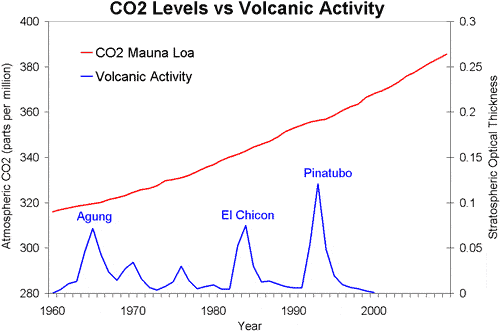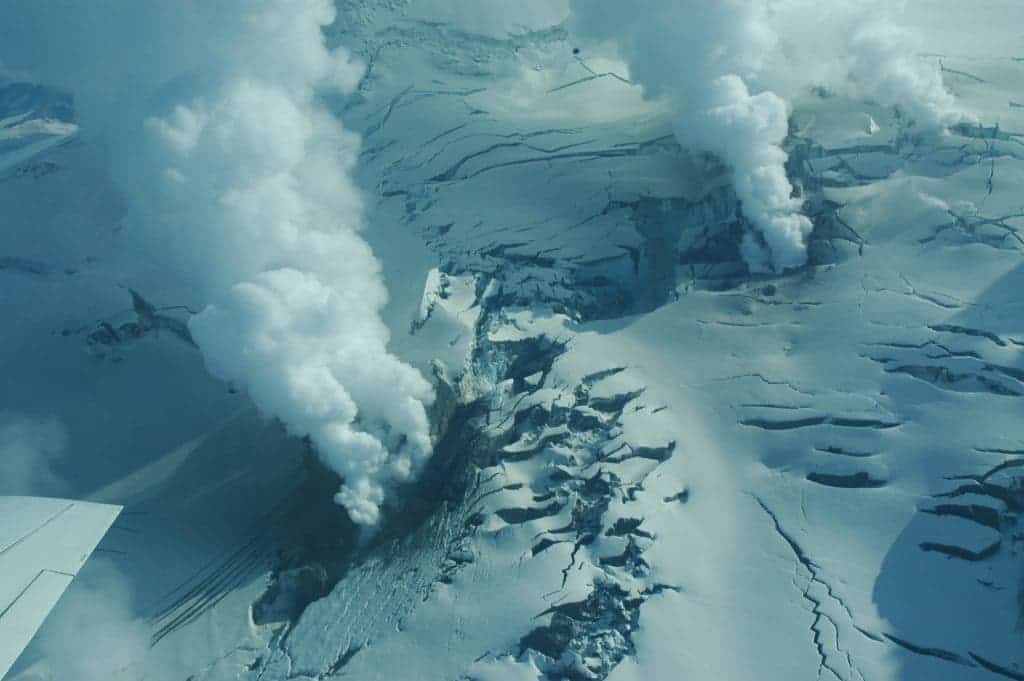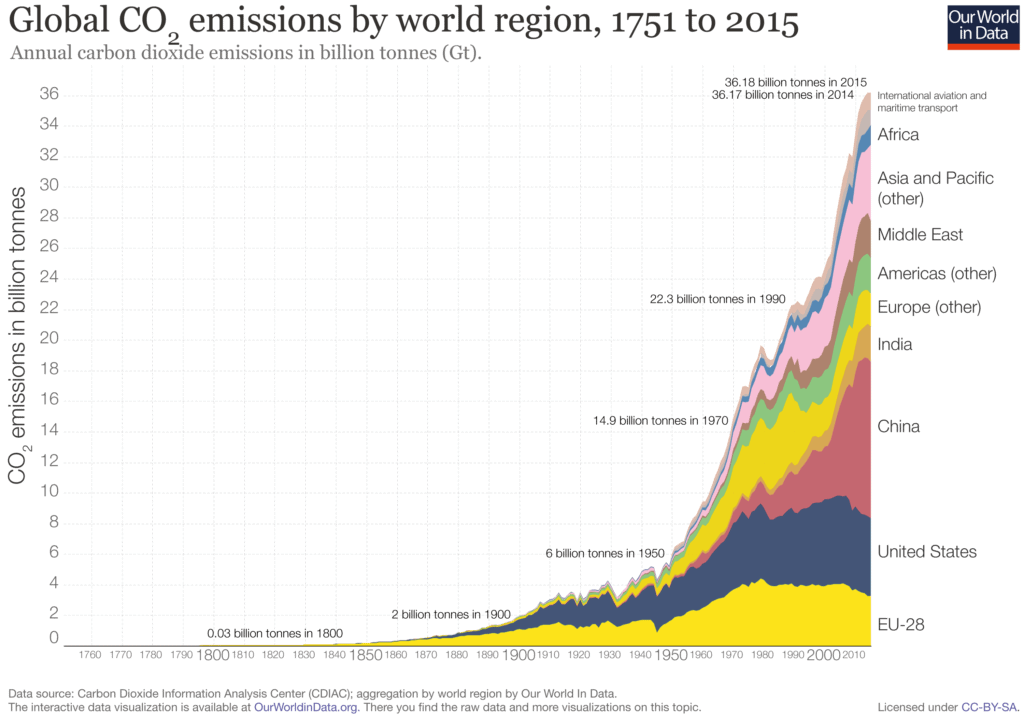No matter how you look at it, even during massive eruptions, mankind still emits much more carbon dioxide than volcanoes. In total, volcanoes barely emit 1% of mankind’s emissions. By itself, the US emits ten times more CO2 than volcanoes do. There’s no reason to point to volcanoes when it comes to climate change.

There’s a big disparity between what scientists know about climate change and how the media talks about climate change. Perhaps unsurprisingly in this situation, plenty of misconceptions have made their way into public discourse. Climate misinformation has spread dramatically and several myths have become pervasive
Among them, there’s this idea that mankind’s emissions just don’t matter. Volcanoes output so much CO2, some people say, it massively overshadows everything we do.
But the data paints a very different story. No matter how you look at it, volcanoes don’t emit more CO2 than humans.
Volcanic CO2
The United States Geological Survey (USGS), alongside several other similar organizations, monitors volcanic emissions. According to their data, volcanoes (both land and underwater volcanoes) emit 200 million tons of carbon dioxide (CO2) annually. Of course, it’s not exactly a linear figure and major eruptions can bring dramatic changes. But in the long run, these episodic changes don’t define what happens.

The eruption of Mount Pinatubo, for instance, brought vast changes to the atmosphere. It ejected roughly 10 billion tonnes of magma, bringing vast quantities of minerals, toxic metals, and of course, greenhouse gases. It spewed more aerosols than any eruption since Krakatoa in 1883. By the time it was all finished, 42 million tonnes of CO2 were ejected into this atmosphere.
But even with this eruption, volcanic activity didn’t match human activity. Ironically, aerosols from Pinatubo’s eruption formed a layer that dropped global temperatures by about 0.5 °C (0.9 °F) in the years 1991–93. In fact, as we’ll see soon, volcanoes can also cause global cooling
The data from the British Geological Survey, the British equivalent of the USGS, is quite different. Their estimations claim that volcanoes emit 300 million tonnes CO2 on an average year. This is, as far as we could find, the higher estimation for volcanic CO2. However, that is also not even close to the anthropic contribution.
In other words, even higher estimates for how much CO2 volcanoes emit don’t even come close to what humans do.
Mankind CO2
While estimates for volcanic CO2 vary mostly between 200 and 300 million tons, our own CO2 emissions range around 24 billion tons — and that figure speaks for itself. No matter how you look at it, 2.4 gigatons are much more than 0.3.
Mankind’s activity dwarfs the of volcanoes, and our emissions are constantly growing, year after year. As volcanologists emphasize, it doesn’t even make much sense to compare the two.
“In fact, present-day volcanoes emit relatively modest amounts of CO2, about as much annually as states like Florida, Michigan, and Ohio,” writes USGS scientist Terrence M. Gerlach. “Anthropogenic CO2 emissions—responsible for a projected 35 gigatons of CO2 in 2010 [a figure that has grown significantly since] — clearly dwarf all estimates of the annual present-day global volcanic CO2 emission rate. Indeed, volcanoes emit significantly less CO2 than land use changes (3.4 gigatons per year), light-duty vehicles (3.0 gigatons per year, mainly cars and pickup trucks), or cement production (1.4 gigatons per year).
In case you’re wondering, there’s really not a lot of uncertainty around this. If volcanoes would be the driving factor of the atmospheric CO2 rise, we would see a correlation between volcanic eruptions and this steep rise in CO2 — and we don’t.
Furthermore, a global volcanic CO2 output exceeding 35 gigatons per year would mean that the annual mass of volcanic CO2 is more than 3 times greater than the mass of erupted magma (~10.8 gigatons per year), and that’s simply not believable. Lastly, even if these estimates are a bit off, and even if they are way off, there’s still no term of comparison between volcanic and human CO2 emissions.
Volcanoes and climate change
While volcanoes do contribute to climate change to a certain extent, their role is complex and multilayered. Volcanoes can and have affected the Earth’s planet through several processes. Here are some of the main ways volcanoes interact with the climate:
- Carbon Dioxide Emissions: Volcanoes release carbon dioxide (CO2) into the atmosphere, which can contribute to warming because CO2 is a greenhouse gas. However, as mentioned previously, the amount of CO2 released by volcanoes is minor compared to human-generated emissions.
- Sulfate Aerosols: When volcanoes erupt, they also emit sulfur dioxide (SO2), which can form sulfate aerosols in the atmosphere. These aerosols reflect sunlight back into space and have a cooling effect on the planet. The effect can be local or, in the case of very large eruptions, global. The most famous recent example is the eruption of Mount Pinatubo in the Philippines in 1991, which resulted in a temporary global decrease in temperature.
- Particulates: Volcanoes also emit small solid and liquid particles that can reflect sunlight, also having a cooling effect. These can be local or global, depending on the size of the eruption.
- Effects on Ozone Layer: Some volcanic gases can impact the ozone layer, which protects Earth from harmful ultraviolet (UV) radiation. For instance, the eruption of Mount Pinatubo led to a temporary thinning of the ozone layer.
- Ash and Dust: Volcanic ash and dust can block out sunlight, leading to cooling. This effect is usually short-lived, as ash and dust fall out of the atmosphere relatively quickly.
- Long-term Effects: Over geological time scales (millions of years), volcanoes have played a significant role in the Earth’s climate by releasing greenhouse gases into the atmosphere. However, these processes occur over such long time scales that they’re not generally relevant to current human-induced climate change.
The bottom line
CO2 is a greenhouse gas and it is the main culprit we blamed for climate change. While other gases (most notably, methane) also play a role, it’s carbon dioxide that we need to address if we want to address climate change.
Volcanoes emit a significant amount of carbon dioxide into the atmosphere, but nowhere near what humans emit. We know this with a great degree of certainty.
Estimates for how much volcanoes and humans emit vary. But no matter what estimates you look at, volcanoes aren’t the problem. Human activity is causing the current climate change episode, and the only way to tackle it is to reduce our emissions.




